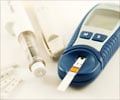
It's important to check your blood sugar levels regularly and make sure you lower it if necessary. Too high of a blood sugar level, especially over a prolonged period, can damage many areas of the body.
Insofar as the eyes are concerned, diabetes can damage the blood vessels in your eyes.
This damage can lead to glaucoma, cataracts, structural changes to your retina, even blindness.
When blood vessels are damaged, nerve signals can't reach your eyes.
In addition, having diabetes can lead to a buildup of pressure from fluid, which can compress nerves and other structures in your eyes.
Advertisement
When we look at something, light passes through the front of the eye, and is focused by the lens onto the retina. The retina is a delicate tissue that is sensitive to light. It converts the light into electrical signals that travel along the optic nerve to the brain. The brain, in turn, interprets these signals to "see" the world around us. The retina is supplied with blood by a delicate network of blood vessels.
Advertisement
Light is focused onto an area of the retina called the macula, which is about the size of a pinhead. This highly specialised part of the retina is vital, because it allows you to see fine detail for activities such as reading and writing, and to recognise colours.
The rest of the retina gives you side vision (peripheral vision). The eye is filled with a clear jelly-like substance called the vitreous gel. Light passes through the gel to focus on the macula.
The most serious eye condition associated with diabetes involves the network of blood vessels supplying the retina. This condition is called diabetic retinopathy.
The unusual changes in blood sugar levels resulting from diabetes can affect the lens inside the eye, especially when diabetes is uncontrolled. This can result in blurring of vision which comes and goes over the day, depending on your blood sugar levels.
A longer term effect of diabetes is that the lens can go cloudy and this is called a cataract.
Not everyone who has diabetes develops an eye complication. Of those that do, many people have a very mild form of retinopathy which may never progress to a sight threatening condition.
In diabetic retinopathy, diabetes affects the tiny blood vessels of the eye and if they become blocked or leak then the retina and possibly your vision will be affected.
The extent of these changes determines what type of diabetic retinopathy you have. Forty per cent of people with type 1 diabetes and twenty per cent with type 2 diabetes will develop some sort of diabetic retinopathy.
In diabetic retinopathy, the blood vessels in the retina are only very mildly affected, they may bulge slightly (microaneurysm) and may leak blood (haemorrhages) or fluid (exudates).
As long as the macula is not affected, vision is normal and you will not be aware that anything is wrong.
Your retinal screening test will keep a close check on these early changes and ensure that any signs of progression to more serious stages of retinopathy are detected early.
Maculopathy means that your macula is affected by retinopathy.
If this happens, your central vision will be affected and you may find it difficult to see detail such as recognising people's faces in the distance or seeing detail such as small print.
Most maculopathy can be treated with laser with the aim of preserving as much vision as possible. The amount of central vision that is lost varies from person to person. However, the vision that allows you to get around at home and outside (peripheral vision) is not affected.
If diabetic retinopathy progresses, it can cause the larger blood vessels in the retina to become blocked. These blockages can result in areas of the retina becoming starved of oxygen. This is called ischaemia. If this happens the eye is stimulated into growing new vessels, a process called neo-vascularisation.
This is the proliferative stage of diabetic retinopathy, and is nature's way of trying to repair the damage by growing a new blood supply to the oxygen starved area of your retina.
Unfortunately, these new blood vessels are weak, and grow in the wrong place - on the surface of the retina and into the vitreous gel. As a result, these blood vessels can bleed very easily which may result in large haemorrhages over the surface of the retina or into the vitreous gel. These types of haemorrhages can totally obscure the vision in the affected eye as light is blocked by the bleed. With time the blood can be reabsorbed and vision can improve.
Extensive haemorrhages can lead to scar tissue forming which pulls and distorts the retina. This type of advanced diabetic eye disease can result in the retina becoming detached with the risk of serious sight loss.
Only between 5 and 10 per cent of all diabetics develop proliferative retinopathy. It is more common in people with type 1 diabetes than type 2. Sixty per cent of type 1 diabetics show some signs of proliferative disease after having diabetes for 30 years.
The following action reduces your risk of developing retinopathy or helps to stop it from getting worse:
• controlling your blood sugar (glucose levels)
• tightly controlling your blood pressure
• controlling your cholesterol levels
keeping fit, maintaining a healthy weight and giving up smoking are all part of good diabetes control. Nerve damage, kidney and cardiovascular disease are more likely in smokers with diabetes. Smoking increases your blood pressure and raises your blood sugar level which makes it harder to control your diabetes regular retinal screening (see more below). The most effective thing you can do to prevent sight loss due to diabetic retinopathy is to attend your retinal screening appointments. Early detection and treatment prevents sight loss.
Risk factors that cannot be controlled:
• the length of time you have had diabetes. This is a major risk for developing diabetic retinopathy.
• your age affects the progression of diabetic retinopathy
• your ethnicity.
Studies have suggested higher levels of diabetic retinopathy in certain ethnic groups, while other work has suggested that these differences are due only to social factors.
Most complications can be treated, but it is vital that they are diagnosed early. They can only be detected by a detailed examination of the eye carried out at a specialist screening centre.
Most sight-threatening problems caused by diabetic retinopathy can be managed by laser treatment if detected early enough. The aim of laser treatment is to prevent bleeding or to prevent the growth of new blood vessels. The laser can be used in two ways: Localised Laser Treatment where laser can seal leaking individual vessels or small groups of vessels and help reduce the swelling of the retina. This type of treatment is quick, sometimes taking only a few minutes, and Pan-retinal Laser Treatment, which aims to treat large areas of the peripheral retina with the laser. This treatment stops the retina from producing the growth factors that stimulate new blood vessels to grow. If the treatment is successful, the new vessels shrink and disappear over a few months.
You can usually be treated in an outpatient clinic and do not normally need to stay in hospital. Eye drops enlarge your pupils so that the eye specialist can look into your eye. Your eye is then numbed with drops and a small contact lens is put onto your eye to stop it blinking. During the treatment you will be asked to move your eyes in certain directions and you will be able to do this easily with the contact lens in place. When treatment is first suggested, ask how long each session is likely to last. Some people need more than one treatment session.
Local treatment for sealing blood vessels does not usually cause discomfort. Pan retinal treatment can be uncomfortable, so you may need a pain-relieving tablet at the same time as the eye drops. Further pain relief is available so remember:
Important points to remember:
• Early diagnosis of diabetic retinopathy is vital.
• Attend your retinal screening appointment.
• Don't wait until your vision has deteriorated to have an eye test.
• Speak to your diabetic eye clinic if you notices changes to your vision.
Most sight-threatening diabetic problems can be managed by laser treatment if it is done early enough. Don't be afraid to ask questions or express fears about your treatment.
Good control of sugar, blood pressure and cholesterol reduces the risk of diabetes-related sight loss.
Attend your diabetic clinic or GP surgery for regular diabetes health checks, including blood pressure and cholesterol monitoring.
Smoking increases your risk of diabetes-related sight loss. Your GP can tell you about NHS stop smoking services in your area.
Diabetologists and the medical fraternity say that it is essential to follow a prescribed diet recommended by your doctor or dietitian to prevent diabetes affecting any part of the body.
It is recommended that an individual undertake at least 30 minutes of exercise each day and take diabetes recommended medication.
It is also recommended that blood sugar and blood pressure is monitored often to keep both under control.
If pregnant, seeing your eye doctor within the first trimester of pregnancy is advised.
Source-ANI















